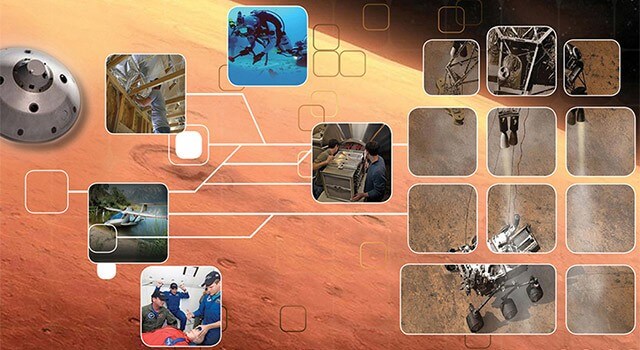Water filtration bottles, comfortable car seats and remote medical monitoring devices all have one thing in common — they all have benefited from NASA technology.
These products are featured in Spinoff 2013, an online publication now available that highlights commercial products created using NASA-developed technology, including some developed at the agency’s Jet Propulsion Laboratory in Pasadena, Calif. Also featured in the 2013 edition is an air purification system that can sustain miners in the event of a disaster, a solar-powered vaccine refrigerator saving lives in remote areas throughout the world, and a powerful heat shield used on the first commercial spacecraft to successfully achieve orbit and return to Earth.
“NASA develops technologies to push the boundaries of what’s possible in space, but those same technologies also make life better here on Earth,” said Daniel Lockney, NASA’s Technology Transfer program executive. “Spinoff 2013 is filled with examples of how NASA technology benefits our lives every day.”
NASA has a long history of transferring technologies from their original mission applications to secondary uses. For example, Mars continues to be a rich destination for scientific discovery and exploration, and NASA’s missions there have inspired a variety of practical, terrestrial benefits. Spinoff 2013 features stories about some of these technologies, including a wind turbine that could one day be used to provide energy for a human exploration mission on the Red Planet, and is being used today in harsh environments here on Earth.
New to Spinoff this year is a section called “Spinoffs of Tomorrow,” which showcases 18 NASA technologies currently available for licensing and partnership opportunities.
NASA’s Technology Transfer Program is charged with finding the widest possible applications of agency technology. Through partnerships and licensing agreements with industry, the program ensures NASA’s investments in pioneering research find secondary applications that benefit the economy, create jobs, and improve quality of life. Spinoff 2013 is available online at: http://spinoff.nasa.gov/ The California Institute of Technology in Pasadena manages JPL for NASA.
If our reporting has informed or inspired you, please consider making a donation. Every contribution, no matter the size, empowers us to continue delivering accurate, engaging, and trustworthy science and medical news. Independent journalism requires time, effort, and resources—your support ensures we can keep uncovering the stories that matter most to you.
Join us in making knowledge accessible and impactful. Thank you for standing with us!


This article may unstable a person’s argument against the space race.
As a lover of astronomy and astrophysics, it is very encouraging and humbling to see just how much NASA has done. Not only for the Space Race, but for mankind in it’s entirety.
Many of the technologies and common appliances which we take entirely for granted are in fact a result of NASA’s hard work and research into reaching what lies beyond the bounds of planted Earth. Things such as cell phones, microwaves, and computers; to name but a few.
It is very clear that the work NASA has done has given us great advances in technology and science, as well as huge quality of life improvements. And such benefits will only become greater the more we learn.
Thus, research into the unknown aspects of our universe deserves the attention of top minds and governments alike, for the betterment of our own future.
____
John Davidson
u14027781
It is astonishing to realize that NASA even has a very important purpose in space, but on Earth as well. NASA technology can thus be used for secondary applications to benefit life on Earth, to increase life quality and to decrease the damage of a mine disaster(through the air purification system). NASA’s innovation of technology can help life on Earth by being beneficial not only to the terrestrial area but by using the technology that was developed for Mars in harsh conditions here on Earth. The development of the technology that is occurring at NASA should be more supported be people looking to improve the lives here on Earth. And the development at the moment should be focused on by scientists looking for ways to improve the quality of life on Earth. Even more partnerships should be created with NASA to strive for the development of technology to improve the life on Earth and more organizations should follow NASA’s example by not only developing technology for their main focus area but also striving to use that technology for secondary application to benefit the lives on Earth.
This article is a highlight of how influential NASA has been to our lives. It might not have a direct link to our lives, but the technology that has been derived from NASA’s scientific projects does have a direct link with our lives, for example the comfort of our car seats. A great deal of technologies that we use today have been borrowed from NASA. To name but a few, remote health monitors (which were originally used to remotely monitor the health of astronauts in distant space); water filtration bottles (which enabled water reuse); advanced air purification systems and solar powered refrigerators are all masterpieces of technology that NASA has contributed to today’s world. How brilliant!
It is just wonderful how every thing links together. When is started to read about everyday thing that is a result of space research and technology developed by NASA in order to explode the outer scape I was amazed. Even the pillow I sleep on is a result of NASA engineers. It shows us how creative people can be when resorses are limited.
it is amazing how NASA’s space research can also aid in the betterment of some social issues such as unemployment on a broad scale and environmental issues such as climate change through the wind turbine
It is really amazing that many of the items we take for granted are a result of extensive research focused on improving space exploration. It just goes to show that science is an intricate web that integrates many seemingly unrelated sources of knowledge in order to create something new.